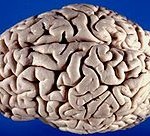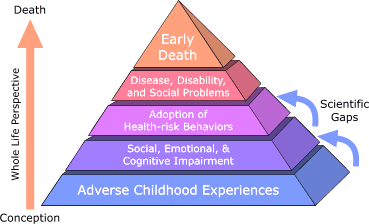 When we last left Stewart the 92-year-old lawyer in Dan Siegel’s office June 25, “the presenting problem was: his wife got sick, and he became more socially withdrawn… losing himself in his books,” Siegel said. “Rather than confronting what the illness of his wife of 65 years brought up in him, this unbelievable sense of vulnerability which he wasn’t prepared to sit with, he withdrew into his law books.” [FN1]
When we last left Stewart the 92-year-old lawyer in Dan Siegel’s office June 25, “the presenting problem was: his wife got sick, and he became more socially withdrawn… losing himself in his books,” Siegel said. “Rather than confronting what the illness of his wife of 65 years brought up in him, this unbelievable sense of vulnerability which he wasn’t prepared to sit with, he withdrew into his law books.” [FN1]
Stewart could handle and remember lots of facts, like his or others birth dates, a left brain function. But he had little or no emotional response, nor could he recall much about his fleshed-out lived experiences, like what he did on his son’s first birthday, a right brain function. Pure dissociation. “I think you’re living with half a brain,” Siegel told him.
So Dan set out to grow Stewart’s right brain.
“Our right human hemisphere is all about this present moment,” says brain scientist Jill Bolte Taylor. “Information, in the form of energy, streams in through all of our sensory systems, then it explodes into an enormous collage of what this present moment looks like, what this present moment smells like and tastes like, what it feels like and sounds like.” [FN2]
Here’s what Dan did: “I told Stewart that I thought if we could drive energy and information flow through the right hemisphere of his brain, over a three to four month period, I believed we could stimulate neuronal activation and growth: we could get new synapses to form in the right brain that had never formed before.”
Dan gave Stewart a series of exercises which only the right brain could handle, so the neurons in Stewart’s spectacularly developed logical left brain would have to just stop firing awhile. His right brain would have to step up. [FN3]
Fire the Right Brain Neurons
 First, Siegel said, the right hemisphere specializes in non-verbal responses, facial recognition and imitation, and other mammal to mammal relational expressions and body language – as distinct from verbal language and logic which are left brain actions.
First, Siegel said, the right hemisphere specializes in non-verbal responses, facial recognition and imitation, and other mammal to mammal relational expressions and body language – as distinct from verbal language and logic which are left brain actions.
So Dan started miming emotions with his face and body, only — no words. And Stewart had to try to mimic back his face and body motions — no words. “I would make a face, and he would imitate it—not name it because that would be bilateral integration, ” said Dan. “We wanted to get his right hemisphere going, and the right specializes in non-verbal response and facial recognition.” Stewart watched while Dan demonstrated an emotion non-verbally, with face, with hands and body, and gradually Stewart found he could make his own face, hands and body imitate Dan — all without logic or speech.
Then Dan reversed it, having Stewart mime something without words, while Dan tried to imitate him. “It kind of became fun actually, like a game,” Dan said. “For homework, I would have him watch television with the sound turned off, so that his left hemisphere, which does language, wouldn’t get stimulated. The right hemisphere had to start watching the shows, and he had to get his right hemisphere to work.”
Second, Dan knew that emotions, as the word implies, arise first as bodily sensations — motion in the body parts — which is communicated as raw data via body nerves to the brain, and finally analyzed and interpreted by the mind as “feelings.” But emotions, like most bodily data, are shunted to the right side of the brain for interpretation, as Dr. Jill Bolte Taylor describe the way incoming sensory data goes to the right brain, above.
Dan thought Stewart didn’t have that right brain function of assembling a map of how his body felt — which was why he didn’t have emotions. So he taught Stewart to create in his mind, an integrated map of his body, which only the right brain can do.
Dan taught Stewart to do “body scans,” in which attention is focused strongly and willfully (“mindfully”) on what is going on first in our head, then our face, neck, chest, belly, legs, and so on, for prolonged periods of time — something Stewart had never spent 10 minutes on in 92 years. “He couldn’t check into his body to say, my heart is pounding, my stomach is churning, I’m breathing fast,” said Dan, so how could he know he was feeling an emotion?
Third, Dan gives Stewart autobiographical exercises. “I asked him, ‘before you came to the office, you woke up. How did you wake up?’ He said he got up, he had breakfast, and he got in the car. I said ‘Let’s back that up, which foot got out of the bed first?’ He had to go from factual memory, to having a sense-of-self in time. That’s a right hemisphere specialty. Obviously your sense of self, if you don’t have an autobiographical sense of self, is pretty thin.
“Now you would say: hold on, my left foot got up, and then I had breakfast. How? You didn’t fly to the kitchen…Well I went to the toilet first, then I washed my face, then I took a step, etc… Then he would start making a map of what he experienced that morning…
“And over time, with autobiographical memory exercises, non-verbal exercises, bodily exercises, and starting to then name feelings, we would put on facial expressions of these feelings — and then he started to change. It was actually quite startling.
“One moment is telling… He had mentioned that his brother had lost his leg in a skiing accident, but it didn’t matter, you know, because of his dismissal of relationships. He knew the facts of it, but not the feelings of it. A few months later, he was saying something about his grandchildren going skiing, and I thought there was something related to his brother, so I brought it up and he started to get tearful. I asked him if it was about his brother, he said no.
“I asked him what he was feeling and he looked at me and said that he couldn’t believe that I had remembered what he’d said, and that I really knew him. He said, ‘I can’t believe you remember who I am.’ And there was this shift of the feeling of his presence in the room. He began to be able to articulate that he felt sad, that he could feel heaviness in his chest, that he was aware of his body in new ways.
“It was a moment of connection with him that didn’t exist before. And from that time onward the feeling in the room was like I had a whole person with me. There was this natural unfolding. Once you allow these areas to be differentiated and honored, they can naturally find a linkage often. And that’s what happened with Stewart.
“Empathy became something he did. With the right hemisphere focused on his interior, it also naturally began to focus on the interior of other people — me, his wife, his friends. And that Presence you have when you’re interested in the interior world of other people, is a totally different way of being on the planet.
“His son reported that his presence around his grandchildren really changed. There was even one time Stewart came in and told me that I wasn’t going to believe what happened. He said they were saying goodbye to some people, and his wife put her hand on his shoulder, and he told her it felt good. Then she asked him if he wanted a back massage because in 65 years of marriage, he never let her do that. So she gave him a shoulder massage, and he said it felt fantastic. I asked why he’d said no for 65 years, and now at 92, he said yes.
“He said that he had been so terrified his entire life of needing anyone because he was never able to need anyone in his childhood, and that now he felt as if he could be that vulnerable to his wife and he could say that he needed her.
“His wife actually called me and asked me if I had given him a brain transplant because he had become a different person. It wasn’t just that he was more present with relationships; internally, he felt this sort of playfulness. So, that’s how we could tell that something shifted with him.
“It was incredible and I have to say if it were just Stewart, I’d feel really nervous about reporting such a thing in a book, but I’ve worked with a lot of people with avoidant attachment histories, who as adults have dismissed attachment with the same paradigm, and it comes out the same way almost every time. [FN5]
“Now I get these beautiful cards from Stewart every winter. The last one said, ‘Dan, you cannot believe how much fun I’m having. Thank you’.”
——————
Next Friday August 15: Special guest blog on how the ACE Study is finally being put to good use in pediatrics
——————
Kathy’s news blogs expand on her book “DON’T TRY THIS AT HOME: The Silent Epidemic of Attachment Disorder—How I accidentally regressed myself back to infancy and healed it all.” Watch for the continuing series each Friday, as she explores her journey of recovery by learning the hard way about Attachment Disorder in adults, adult Attachment Theory, and the Adult Attachment Interview.
Footnotes
Bio, website, and more of Dan’s books in Footnotes at end of http://attachmentdisorderhealing.com/Daniel-Siegel-3/
FN1 Siegel, Daniel J., MD, “The Developing Mind,” National Institute for the Clinical Application of Behavioral Medicine (NICABM), Apr 6, 2011 p.20-22 www.nicabm.com Apr 6, 2011 p.20-22
FN2 Jill Bolte Taylor, “My Stroke of Insight,” Ted Talk of Feb. 2008, http://www.ted.com/talks/jill_bolte_taylor_s_powerful_stroke_of_insight
FN3 Siegel, Daniel J., MD, “How Mindfulness Can Change the Wiring of Our Brains,” NICABM, www.nicabm.com; 2010 Webcast; my first NICABM webinar, downloaded March 31, 2011; rebroadcast October 11, 2011. http://www.nicabm.com/nicabmblog/meditation-medication/ and http://www.nicabm.com/mindfulness-2011-new/
FN4 Siegel, Daniel J., MD, “The Developing Mind: How Relationships and the Brain Interact to Shape Who We Are,” (Guilford, 1999). How attachment in infancy and childhood creates the brain and the mind.
7,313 total views, 1 views today


